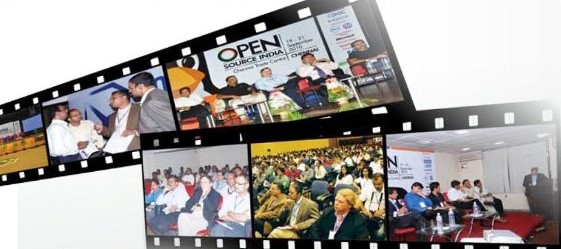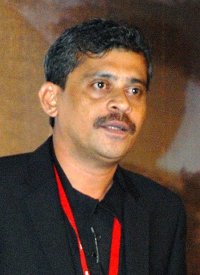
Gone are the days when Open Source Solutions were considered the play-tools of geeks. Over time, open source tools and technologies have emerged as powerful, scalable, flexible, and most importantly, economical alternatives to popular commercial software.
The word is spreading, and spreading very fast — and why not! After all, Open Source is business-ready now, and offers a rich mix of platforms and solutions to businesses of all sizes, across verticals. Technologies like Cloud Computing and Virtualisation promise better returns on investment. And, if you add the element of “Open Source” to the recipe, you might be able to achieve your goals without ever having to bother the finance guys!
Considering the benefits that Open Source can render to businesses, the agenda of last year’s edition of Open Source India 2010 was also centred around the theme: Open Source is Business-Ready.
As we stand at the threshold of the 2011 edition of Open Source India, we thought the time was just right to look back and ask the previous year’s attendees to share their experience, their take on the difference that adopting open source can make to businesses, and a few words on what they expect from the next edition of the event. Here goes…

“Open Source gives me high-quality solutions”
open-source-related knowledge.
I work quite extensively on the open source technology stack, as I work in the embedded field. It was obvious that I would get curious and want to attend the CXO Summit when I got to know about it. My goal was to know about the developments in my field. Plus, with cloud computing becoming a hot technology trend, my desire to learn more only intensified.
Experiences at the CXO Summit 2010: The Summit facilitated interaction with participants, and was a tremendous source of knowledge on open source tools and processes, and also on the resources available in the cloud.
Tryst with Linux and open source: We work on the Linux platform and use open source tools such as GCC, Eclipse, OpenOffice, Uboot, etc. We are using open source Linux for some of our embedded boards based on Freescale, TI and ATMEL processors. Our main focus is on building customised solutions for the defence sector. We understand their requirements and design customised boards for their applications,
and the customised firmware and BSP (board support package) for these boards.
Why I feel open source rocks for businesses: The key advantage of using open source is that we can develop customised solutions for our customers in an economical way, without any restrictions. Availability of abundant community support is another bright side of open source. Sometimes, we can find and straight away use tested/proven utilities (from open source) in our applications.
A word of caution: We may have to optimise Linux and open source code sometimes. But the good part is, adopting open source is manageable, as it is possible to seek community support as and when required for any troubleshooting.
A wishlist for the CXO Summit 2011: There could be more discussions on the usage of open source, Linux and security issues.

“The Summit was really awesome for networking and learning about open source”
I had always been keen on building business networks and learning new things about open source. Luckily, I got to know about the OSI event as well as the CXO Summit while searching for open source meets in India, on Google. The event sounded appealing to me, and I instantly made up my mind to attend it.
Experiences at the CXO Summit 2010: The event provided a great networking environment to connect with peers, and excellent opportunities to learn new and interesting things about open source. This made the CXO Summit an awesome experience. The insights into the use of open source, which I got the opportunity to hear about during the event, were very useful. I am extremely thankful to the LFY and OSSCube teams for organising such events, and for promoting open source in India.
Tryst with Linux and open source: I have been using Linux for the past three years. We use Apache, MySQL, Perl, Python and PHP as programming tools. We also use OpenOffice.org and other Linux-based utilities in our office for day-to-day work.
Why I feel open source rocks for businesses: We always recommend that our peers use open source in their business. There are so many reasons for this. Open source is affordable, it has high-tech support from a very huge pool of developers and IT engineers from across the globe. Additionally, Linux boasts of ever-increasing performance, new features, and updates at a very fast pace, without any additional costs.
A wish-list for the CXO Summit 2011: Organisers should offer opportunities that
enable people to network better, such as a networking lunch or dinner. This would be a
splendid way to make the summit’s environment more friendly and open. It will help in
combining socialising with learning.

“Core applications in my company run on the Linux server”
Thanks to my background in open source, I have been waiting for such an event — and when I got to know about the CXO Summit, I was interested in attending it. The CIO Summit 2010 turned out to be a great experience, and was, of course, helpful. Tryst with Linux and open source: Core applications in my company run on the Linux server with MySQL and Tomcat. We use Ubuntu for some of our desktops as well.
Why I feel open source rocks for businesses: I think the expensive licensing costs of non-open source products would definitely make open source a sure-shot hit in organisations. I myself have assumed the role of an open source campaigner in my group.
My vote goes to: While I prefer Red Hat’s software solutions, as they are user friendly, Ubuntu’s rich graphics make it ideal for the desktop. A word of caution: It can prove fruitful if those companies that adopt Linux and open source hire and then make efforts to retain employees possessing open source expertise.

“The open source domain is gaining a lot of traction”
As a company (Wind River Systems), we have always contributed substantially to the open source community. This, coupled with our desire to understand the OSI initiatives in the Indian context, were some of the reasons that brought us to the CIO Summit 2010.
Experiences at the CXO Summit 2010: Overall, it was a useful summit. It was very interesting to see the open source domain gaining a lot of traction.
Tryst with Linux and open source: Our company has the reputation of being one of the leaders in the embedded systems domain. We have embraced Linux and other open source solutions such as Android, MeeGo, Ubuntu and Red Hat. We offer our customers yet another very powerful tool for Linux and Android, called Workbench.
Why I feel open source rocks for businesses: As against proprietary products, open source offers huge advantages in terms of community participation. Also, it eliminates any form of dependency, and brings full control to the user who can manage it internally. Hence, we offer optimised Linux and Android solutions to our customers and community, and encourage the use of open source.
A word of caution: The field of open source technology still poses a challenge in the domain of support and optimised solutions. That’s why, sometimes, companies end up spending a lot of time and resources on leveraging these solutions well.
A wish-list for the CXO Summit 2011: I am keen on learning more about open source usage in different verticals, and also about the embedded segment, through the CIO Summit.

“A great platform for business networking”
I have always enjoyed such technical events and sessions related to computing. It’s an added bonus, if they involve open source as well. That apart, I attended OSI to network with business heads and players in the open source domain.
Tryst with Linux and open source: I have been using Linux and open source tools since my college days, and also in many of the companies that I have worked in. I have always recommended Linux and open source software for software development to many of my peers and friends.
Why I feel open source rocks for businesses: I believe that the following factors make the use of open source conducive for companies:
- Its favourable cost
- Almost everything, including the source code, and documentation of data, is open to the public
- It allows people to share knowledge via forums and websites, without the fear of licence costs, which means less expense and difficulties for training.
A word of caution: Sometimes, the open source licences may not support your company’s best interests. Besides, for a home PC, I feel Windows would be a better option, due to its easier learning curve and better gaming. Linux needs more maturity in these aspects.
A wish-list for the CXO Summit 2011: I suggest that the organisers consider holding parallel sessions to ensure that none of the interesting sessions are missed. Also, it would be good if the attendees are provided with free Wi-Fi access.

“The CXO Summit inspired me to motivate others to use Linux and open source”
I am a regular LFY reader. I came to know about the Open Source India 2010 CXO Summit through the LFY magazine itself. It was a nice experience to attend the event. I felt extremely sad that I missed attending the first two days. Apart from the summit, the seminar about developing the Android phone OS was quite interesting.
Tryst with Linux and open source: Yes, I was using Linux and open source prior to attending the CXO summit. Basically, I am a qualified network and systems administrator, sound designer and engineer. I began reading LFY soon after the completion of my Red Hat course in 2007. With the help of tutorials published in the magazine, I learnt to use Red Hat Enterprise Linux, Fedora and many other Linux software. Instead of using proprietary software, after reading about a particular recording software for Linux which was featured in LFY, I tested it. I came across a few problems initially, but I found the performance of open source video software far better compared to tools such as Premier Pro, Avid, FCP, etc. Using Linux and open source tools, I have also designed one audio-video and networking-related education project for government schools, which is currently pending approval by the education ministry. The CXO Summit inspired me to make use of open source in my organisation, and in turn, motivate others to use Linux and open source.
Why I feel open source rocks for businesses: I strongly recommend open source to organisations because it meets most of my expectations from an enterprise-grade software solution, which are as follows:
- It is secure: I feel for any software tool or platform, security is an important element to consider. Performance and speed come next. Compared to other OSs and tools, open source software offers all these critical elements. Based on the principle of “Less luggage, more comfort”, Linux and open source tools need fewer gigabytes, are less bloated, and offer a higher performance.
- Source code is modifiable: It is possible to edit or re-configure the source code as per the requirements of the organisation.
- Solutions are economical or available for FREE: While proprietary operating systems and tools are expensive and have legal limitations, Linux and open source tools are economical or available for free. Besides, these tools have no legal limitations or binding clauses.
A word of caution: There are also a few pitfalls in adopting Linux and open source, mostly from the users’ standpoint. Invariably, problems arise when there is a lack of understanding on the part of the user, or when there is a lack of expert help available to train the organisation’s employees about the deployed Linux and open source solutions. Also, sometimes, device drivers for some of the open source tools may not be readily available.















































































